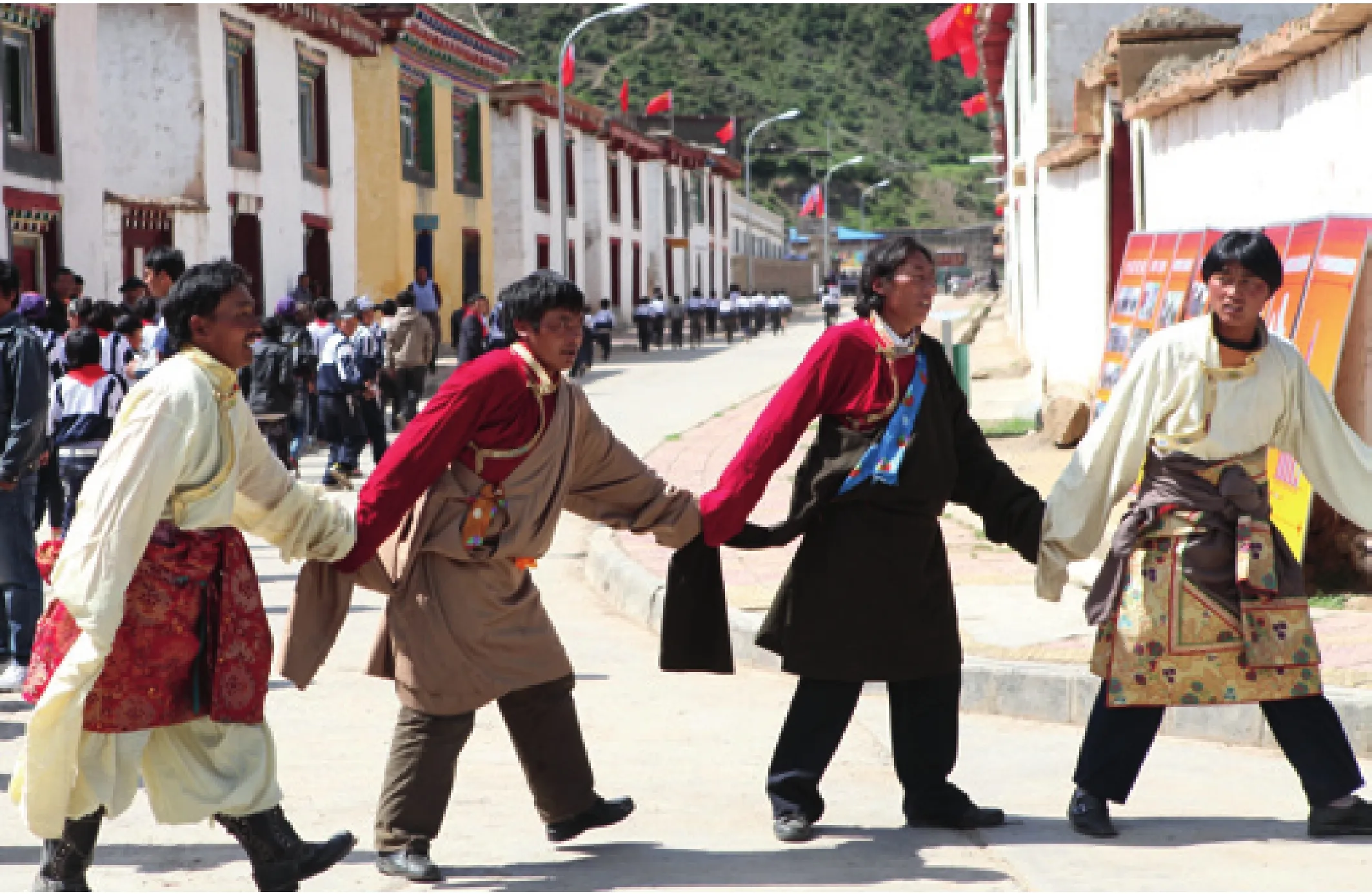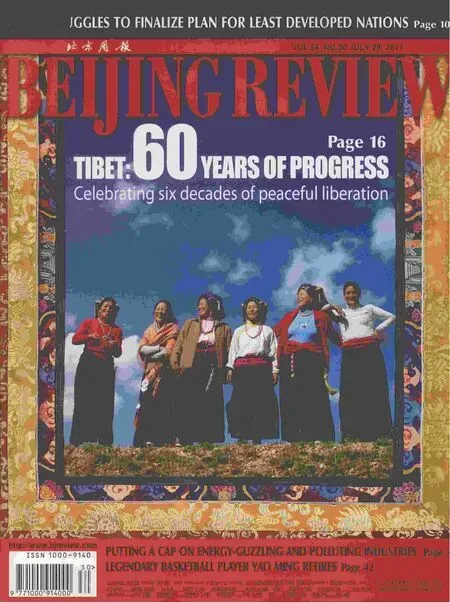Houses Make a Difference
2011-10-14ByWANGJUN
By WANG JUN
Houses Make a Difference
By WANG JUN

NG JIAO
With financial support from the government, more people in Tibet are moving into new residences
To Ahsang, who lives in a two-story
house with his family in Enda Village of Riwoqe County, Tibet Autonomous Region, life in a small, wooden hillside cottage before 2004 is already a distant memory.
Actually, Ahsang had lived there for 60 years. The tiny domicile, while quaint, was hardly what most people would consider a home. The family’s livestock lived in an adjacent room, although the division between man and beast’s living quarters was without solid walls or fences. Without running water or electricity, Ahsang’s family would have to walk downhill half an hour to fetch buckets of water and then haul them back up to the cottage. Television and other home appliances were reserved for the family’s dreams.
Some 110 households in the village used to live similar lives. Scattered about the hillsides, without proper roads, electricity, televisions, radios and telephones, they had little connection with the outside world. Poor infrastructure restricted economic development. In 2004, the per-capita annual net income of Enda villagers was only 2,300 yuan ($356), according to fgures from the county government.
Out with the old
In 2004, the county government began providing subsidies to farmers and herdsmen who built new houses. The government offered each household 60,000 yuan ($9,273.57) for building projects and villagers were allowed to select sites for their new houses closer to one of the country’s major highways.
The government stepped up building of roads, installed street lamps and built public squares in newly built villages. It also launched programs to make electricity, telecommunications services and safe drinking water accessible to all relocated villagers. Due to the efforts, a new primary school was built in Enda.
Having lived their hillside lives for generations, this fash food of change was more than most villagers could accept.
“It was a little diffcult to convince them about the programs,” Wu Xianli, Secretary of the Committee of the Communist Party of China of Sangdo Town, toldBeijing Review.“Some villagers worry they wouldn’t be able to afford the new houses, even with government subsidies.”
Wu said some people were reluctant to move because they were nostalgic to old homes where their ancestors lived and they themselves grew up.
At frst, the fow of households willing to build and move into new houses was only a trickle, but the prospects of a convenient new life in a better house quickly encouraged other villagers to follow suit.
Pema Lhangjia is among those willing to build a new house. Life on the hillside was diffcult, with his children forced to trek down the side of the mountain every day to go to school. Buying daily necessities was an arduous task that forced the family to travel to the nearest town 20 km from their home. When the government launched the relocation program, Pema Lhangjia wouldn’t budge from the home of his forefathers. With fnancial assistance from the government and the possibility of providing a much better standard of living for his family, he eventually gave in.
The benefts of living in the new house are evident. Pema Lhangjia’s children now only spend five minutes walking to school in the morning. The streets of the new village where he lives are lined with stores. With electricity, tap water and natural gas at their disposal, the family’s everyday life has been markedly improved, allowing Pema Lhangjia and his wife to focus on increasing their income.
“Now our life is very good,” Pema Lhangjia toldBeijing Review.
Today, all 118 households in Enda have moved into new houses, each with an average foor space of 300 square meters, according to the government of Riwoqe.
Changing lives
A large portion of Tibet’s population used to reside in mountainous regions and valleys, disconnected from the outside world due to a lack of roads and inaccessible to electricity and safe drinking water. Most people didn’t have telephones, televisions or even radios. It was therefore diffcult to provide education, social security benefits and medical services for these scattered people.

“In some areas, you can ride a bus for four or five hours without seeing a single house,” said Dawa Samdup, director of the offce responsible for rural housing programs of Tibet. “A child from a nomadic family who goes to Lhasa to attend school may be unable to find his or her way home when returning during school breaks.”
Usually made of wood and clay, with flimsy foundations but without earthquakeprotective facilities, houses in rural areas can be amazingly hazardous, Dawa Samdup said.
“After scattered farmers and herdsmen are relocated, the costs for infrastructure construction, such as water, power, water, gas and cable TV systems, have been reduced,”said Dawa Samdup.

WANG JUN
In 2006, the Tibet Regional Government carried out a new program, including reconstructing existing houses, settling of nomadic people and relocating people from povertystricken areas. So far, it has benefited 1.4 million people.
Moving into houses not only provides a healthier living environment for rural Tibetans, it also provides peace of mind.
Dawa Samdup said farmers now spend more time working outside the confines of their homes. Some run their own guesthouses in tourist areas; others are engaged in the transportation industry.
In Enda, the per-capita annual net income of villagers more than doubled the 2004 level to 5,200 yuan ($805) in 2010.
With better infrastructure, farmers and herdsmen have more channels to learn about life outside Tibet.
“For example, through radios, televisions and telecommunications services, farmers can learn more about farming techniques and expand the market for their products. They are learning new ways to sell their vegetables now,” Dawa Samdup said.
Educational facilities have also improved. For example, the primary school, which used to have three grades, now have six grades providing a proper primary school education, Vice Headmaster Pema Sahjen, toldBeijing Review.
“The improvement of housing conditions has played a very important role in raising living standards and boosting infrastructure construction in rural Tibet, increasing income of farmers and herdsmen and promoting stability of the agricultural and pastoral areas,”Dawa Samdup said.
Greater ambitions
Between 2006 and 2010, 17 billion yuan ($2.63 billion) was invested in a variety of housing programs in Tibet. Since Tibet is located in a quake-prone area of the world, the regional government invested another 2 billion yuan ($309.76 million) in reinforcing existing houses.
In 2010, Tibet launched a pilot program to build village libraries, cultural and sports facilities, village-based broadcasting networks and movie theaters. It also began building convenient stores in rural areas and improving village clinics, public lighting systems, road networks, rural garbage and sewage disposal facilities and landscape projects. Investment in the pilot program totaled 527 million yuan ($81.62 million) in 2010, of which 346 million yuan ($53.59 million) was offered by the regional government.
In the five years beginning 2011, the pilot program will be extended to 4,953 villages with a budget of 5.1 billion yuan ($789.90 million), said Dawa Samdup.
